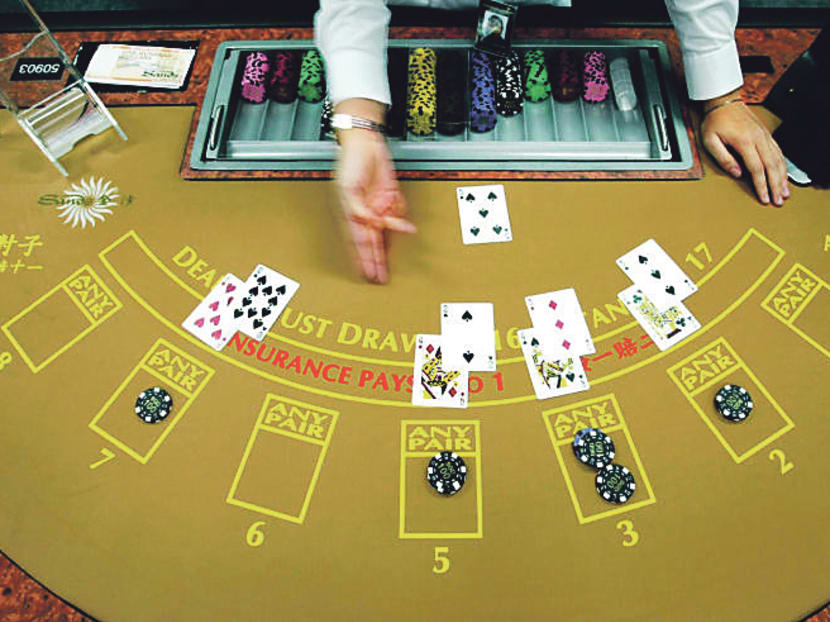Hardcore gamblers fewer, but 'still a worry'
SINGAPORE — Gambling participation rates remain stable and people are spending less on gambling, the latest Gambling Participation Survey has found.
SINGAPORE — Far fewer people are exhibiting signs of being hard-core gamblers and their wagers have also shrunk, the latest gambling participation survey has shown, although the National Council on Problem Gambling (NCPG) still warns that their behaviour warrants concern.
Based on their answers to a questionnaire, only 0.7 per cent of 3,000 residents polled between March and August last year were deemed to be probable pathological and problem gamblers, sharply down from 2.6 per cent in 2011, when a similar survey was last conducted.
Punters assessed to be probable pathological gamblers — the most severe of problem gamblers — made up 0.2 per cent of respondents, down from 1.4 per cent in the last survey, while 0.5 per cent were probable problem gamblers, down from 1.2 per cent.
The questions used to detect probable pathological and problem gamblers were identical to those in previous surveys, said the NCPG.
The bets placed by this group were also found to be a fraction of that in 2011. Probable pathological gamblers bet a median of S$80 and an average of S$313 per month last year, when the corresponding figures the last time round were S$581 and S$1,713. In comparison, the median and average bets for all gamblers were S$20 and S$70.
A higher proportion of these probable pathological gamblers are now gambling more frequently though, and said they started regular gaming before they turned 18.
Giving his take on the 2014 Gambling Participation Survey, Social and Family Development Minister Chan Chun Sing said it was but one data point that the ministry monitors. He also noted that the survey captures the behavior respondents profess, rather than their actual behaviour.
“I think we need to make a distinction between what people say and what people do... what we need to also carefully watch, is what they actually do,” he said.
While the decrease in probable problem gamblers could be due to measures that have been put in place, Mr Chan said the measures’ effectiveness needs to be monitored over time, noting that other countries have seen their problem gambling rates fluctuate.
Clinical director of ECMS Consultants Gerald Goh, whose company offers responsible gambling training to casino operators and also counsels problem gamblers and their families, felt the improvements could be due to awareness campaigns and social safeguards, such as casino visit limits that took effect June 2013.
But addictions management expert and psychiatrist Thomas Lee expressed surprise at the drop in prevalence of probable pathological and problem gambling.
“In any epidemiological survey, when there’s such a big drop in just three years, that means something must have been done to address the issue,” he said, noting that the statistical decrease translates into a significant drop in the absolute number of these hardcore gamblers.
“If the instrument stays the same, the only logical explanation is that these people have recovered,” he added.
The sharp drop in betting amounts could be due to education efforts and more awareness among gamblers to set limits for themselves, said Dr Lee of The Resilienz Clinic in Novena Medical Centre.
On how outreach efforts could target hardcore gamblers — ideas are being discussed with academics, psychologists and social workers, the minister said — Dr Lee said family members could help to give a big push for them to seek treatment.
Gamblers may not be motivated or may be unaware how to seek help, he said. “All my (patients who are) gamblers who do well when they come for treatment, are those with great family support. They’re really hardcore. If not for family members, it would not be likely they would come for treatment, or succeed,” said Dr Lee.
The latest survey also found gambling participation rates to be stable, with 44 per cent of residents participating in at least one form of gambling over a 12-month period, slightly lower than the 47 per cent in 2011.
The NCPG said more people have been seeking help for problem gambling but many remain hesitant to step forward. It will work to expand its network of partners and community counselling services, as well as youth outreach programmes.
Youths may be vulnerable, given their exposure to free social gambling simulation games, said NCPG chairman Lim Hock San.
First Gambling Activity and First Regular (i.e. at least once a week) Gambling Activity (%) (Click to enlarge)
Source for tables/chart: National Council on Problem Gambling







